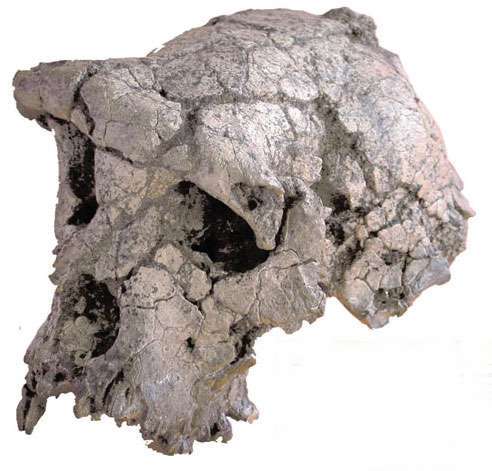| Found: | 2001 |
|---|---|
| Where: | Toros-Manalla site 266, Chad |
| Team leader(s): | Michel Brunet, Alain Beayvilain |
| Temporal range: | 7 to 6 million years ago |
Sahelanthropus tchadensis was described in 2002 by French paleontologist Michel Brunet and his team. It was discovered in Chad from deposits that have been dated by biostratigraphy to between 6 and 7 million years in age. Central Africa is an unusual place to find hominid fossils, and the conditions under which these paleontological teams work are arduous. Their efforts are invaluable for documenting the geographic spread of hominids across the African continent. Many fossils of other animals were recovered at the same site asSahelanthropus, suggesting that the habitat, a dry desert today, was then a lush lakeshore with extensive forests around it.
http://www.becominghuman.org/node/sahelanthropus-tchadensis

| Found: | October 2000 |
|---|---|
| Where: | Tugen Hills, Kenya |
| Team leader(s): | Martin Pickford, Brigitte Senut |
| Temporal range: | 6.1 to 5.8 million years ago |
Orrorin tugenensis is represented by a collection of fossils from the Tugen Hills region of Kenya. Specifically, O. tugenensis is known from four sites in this region: Cheboit, Kapsomin, Kapcheberek, and Aragai. “Orrorin” means “original man” in the Tugen dialect, and “tugenensis” pays tribute to the Tugen Hills region. The sediments in which this specimens have been found are dated to between 6 and 5.8 million years ago using radioisotopic methods, paleomagnetism (dating accomplished using the timing of reversals in Earth’s magnetic poles), and biochronology (dating that utilizes the relative time frames of extinct non-hominin animals). Orrorin tugenensis is important to hominin evolution because it (along with Sahelanthropus tchadensis, from central Africa) may represent some of the earliest evidence for bipedalism in the human fossil record.
http://www.public.wsu.edu/gened/learn-modules/top_longfor/timeline/05_o_tugenensis.html
| Found: | 1997 |
|---|---|
| Where: | Middle Awash, Ethiopia |
| Team leader(s): | Tim White, Gen Suwa, Yohannes Haile Selassie |
| Temporal range: | 5.7 to 5.2 million years ago |
Ardipithecus kadabba is an early hominin species recovered from sediments in the Middle Awash Valley of Ethiopia dated to between 5.2 and 5.8 million years ago. These fossils are of particular importance because fragments from both the skull and body have been found and are argued to demonstrate some of the earliest signs of bipedalism and hominin dental morphology. As one of the oldest species of human ancestors, Ar. kadabbahelps to push back the origin of hominins into the late Miocene Epoch (roughly 11.6 to 5.3 million years ago).
http://dhistorika.blogspot.com/2011/11/ardipithecus-kadabba-un-chimpance.html
| Found: | December 1992 |
|---|---|
| Where: | Aramis, Ethiopia |
| Team leader(s): | Tim White |
Temporal range: | 4.5 to 4.2 million years ago |
http://berkeley.edu/news/media/releases/2004/03/04_Akadab.shtml
| Found: | September 1994 |
|---|---|
| Where: | Kanapoi and Allia Bay, Kenya |
| Team leader(s): | Meave Leakey, Alan Walker |
| Temporal range: | 4.1 to 3.9 million years ago |
Fossils attributed to Australopithecus anamensis (which means “southern ape of the lake” from “anam,” meaning “lake” in the Turkana language) have been recovered from sediments at Kanapoi and Allia Bay near Lake Turkana in Kenya. These fossils, which have been dated to between 4.2 and 3.9 million years ago using radioisotopic dating methods applied to volcanic sediments, are significant because they represent the earliest indisputable evidence of obligate bipedality in the human fossil record. In addition, the morphology of the skull of Au. anamensis provides a glimpse of the evolutionary changes that represent the transition from earlier, more primitive (i.e., ape-like) hominins—such as Ardipithecus ramidus—to later, more derived (i.e., human-like) species—such as Australopithecus afarensis.
https://www.msu.edu/~heslipst/contents/ANP440/anamensis.htm




No comments:
Post a Comment